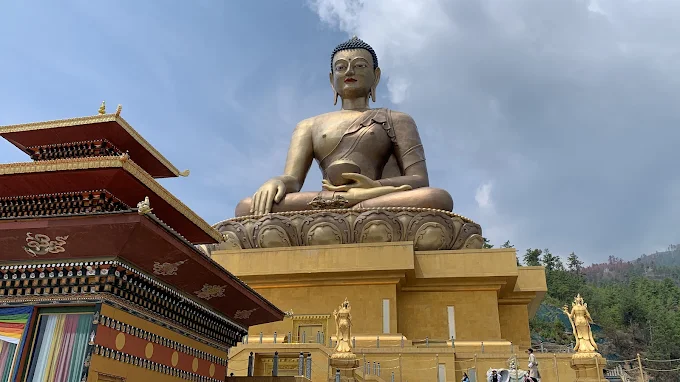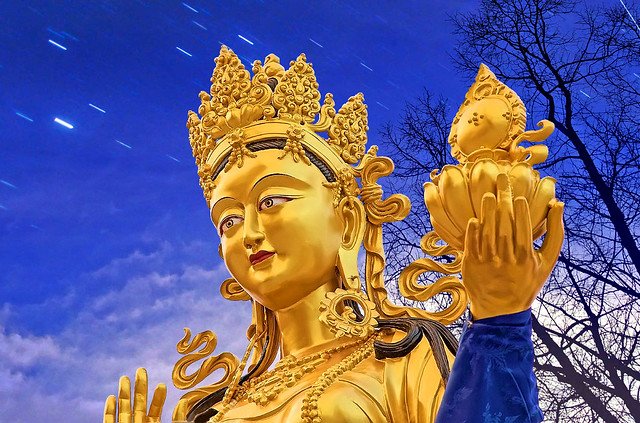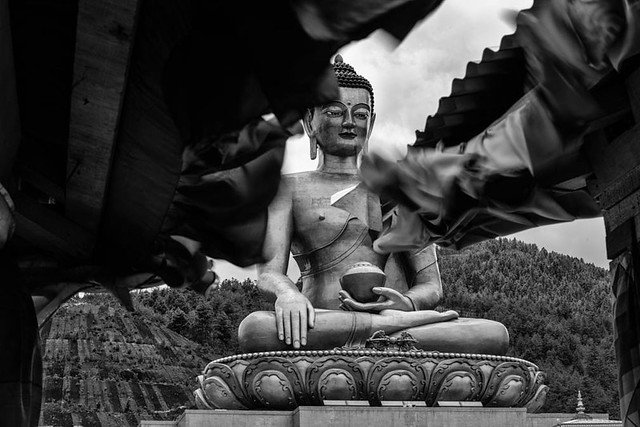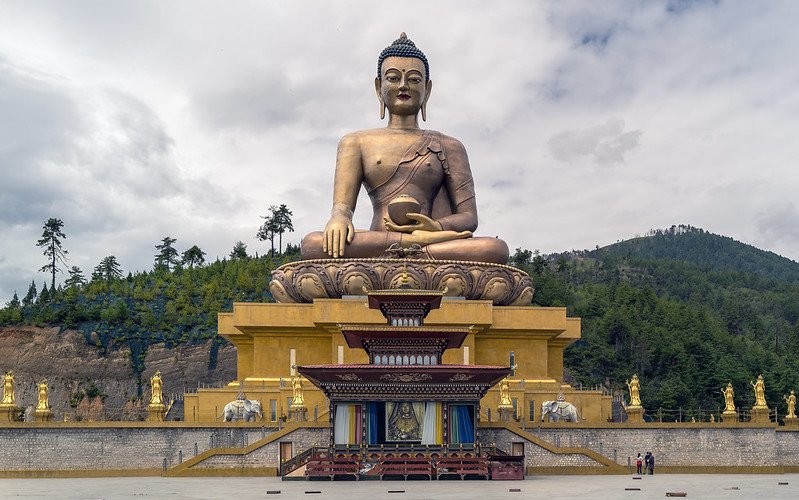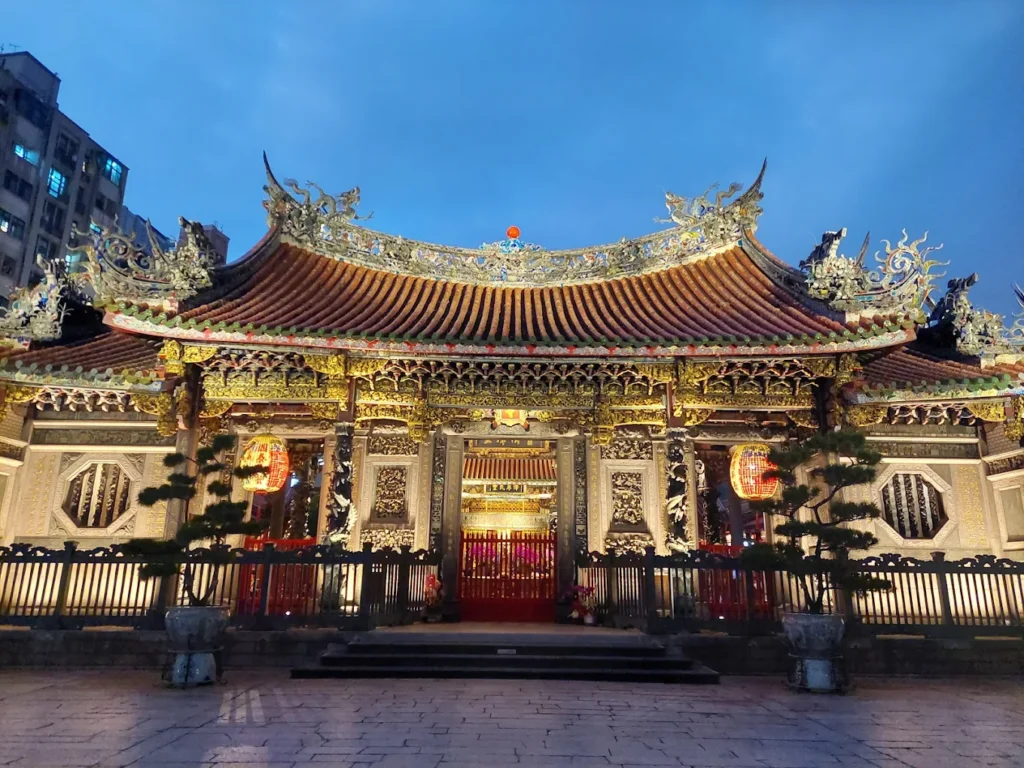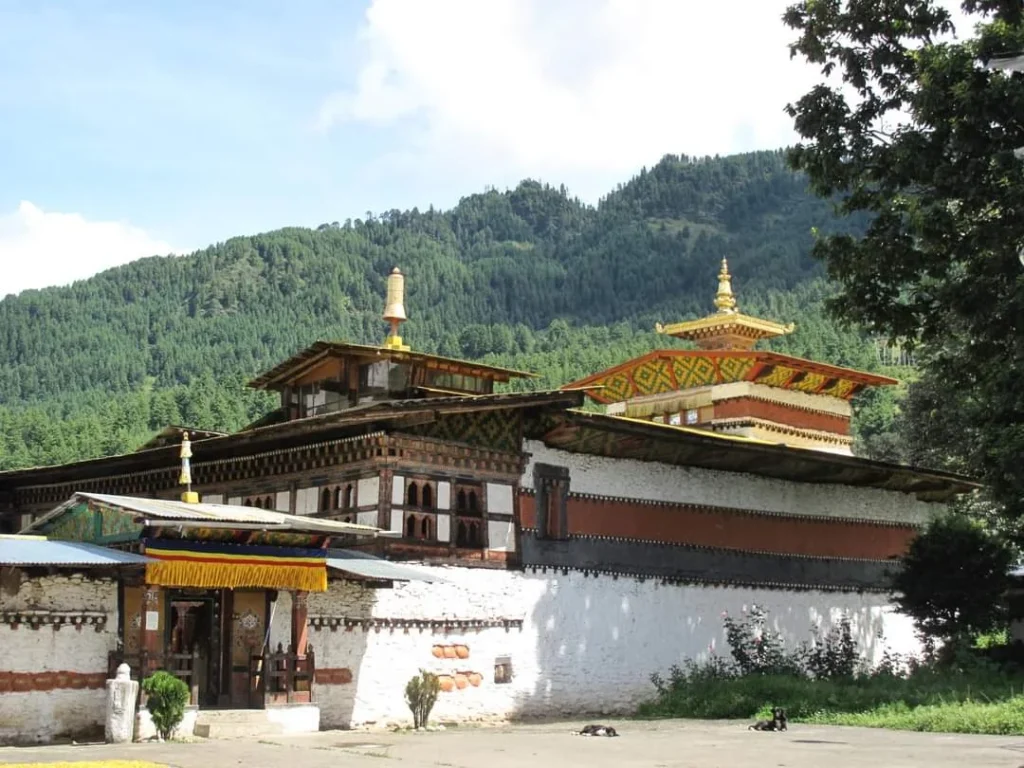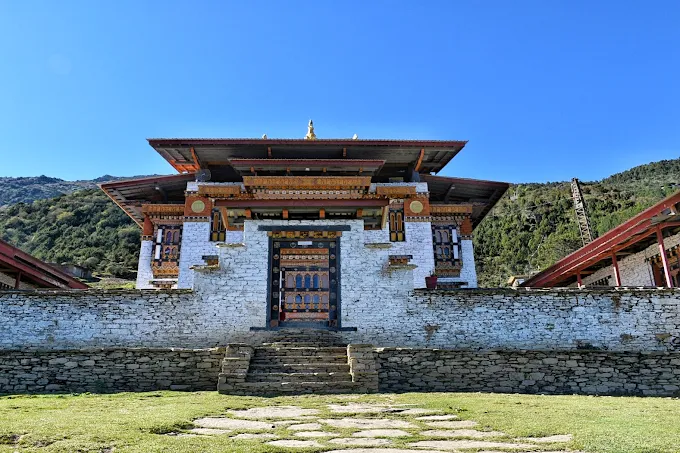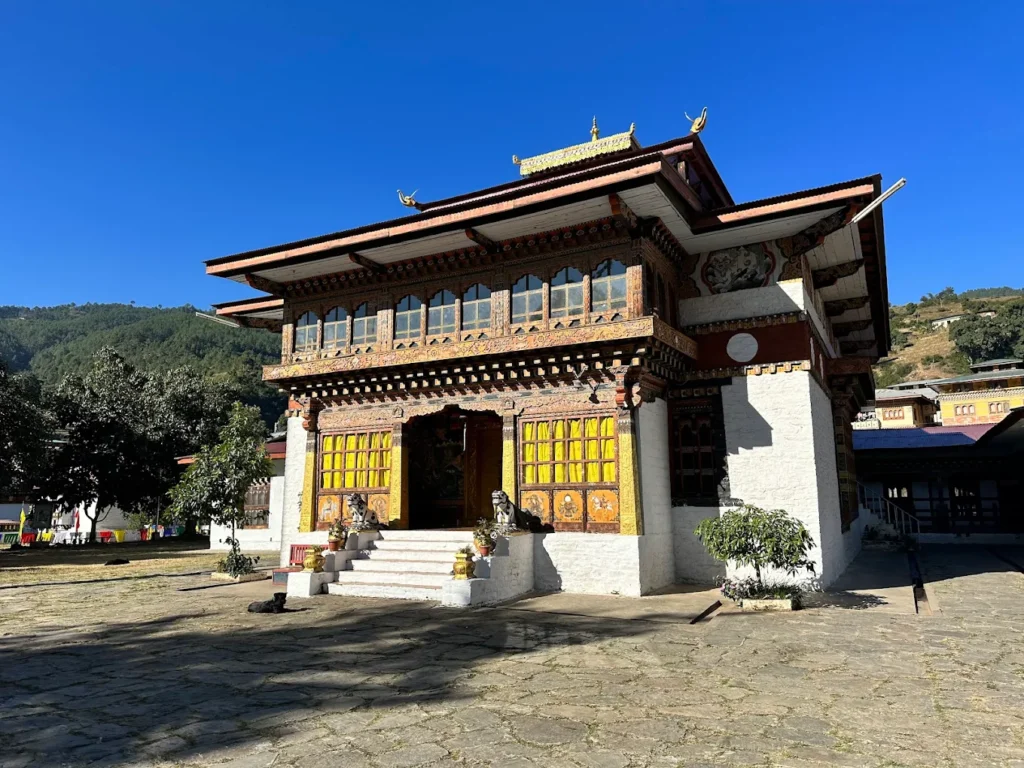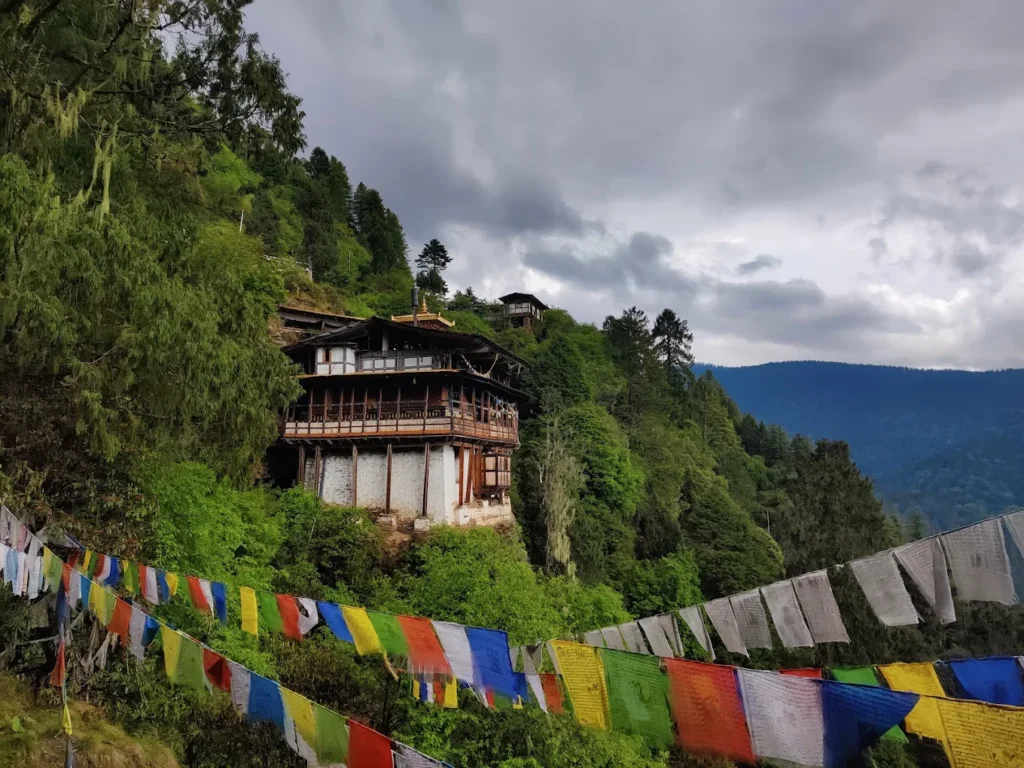Buddha Dordenma: Thimphu’s Golden Guardian of Peace
Atop a hill in Kuensel Phodrang Nature Park, the Buddha Dordenma towers over Thimphu Valley, its golden visage catching the morning mist. Standing 169 feet tall, this Shakyamuni Buddha [Thích Ca Mâu Ni] statue, completed in 2015, is the world’s largest seated Buddha, housing 125,000 smaller gilded bronze Buddhas within its meditation hall. Built to honor the 60th anniversary of Bhutan’s Fourth Druk Gyalpo, Jigme Singye Wangchuck, and fulfill an 8th-century prophecy by Guru Rinpoche, the statue radiates serenity amidst pine forests and prayer flags. Visitors circumambulate clockwise, soaking in panoramic views of Thimphu’s urban pulse below. A symbol of peace and Bhutan’s Vajrayana heritage, Buddha Dordenma draws pilgrims and travelers to its tranquil embrace, blending spiritual grandeur with Himalayan splendor.
Sentinel of Serenity: Overview and Significance
Buddha Dordenma, perched in Thimphu’s Kuensel Phodrang Nature Park, is a monumental icon of Bhutan’s Buddhist culture and national pride. Conceived to promote peace and fulfill ancient prophecies, it stands as a testament to the kingdom’s commitment to Gross National Happiness, captivating global visitors with its scale and spiritual depth.
Historical Roots and Legacy
Construction of Buddha Dordenma began in 2006, spearheaded by Singaporean businessman Rinchen Peter Teo, and was completed on September 25, 2015, under the oversight of Bhutan’s Je Khenpo, Trulku Jigme Chhoeda. Built to commemorate the Fourth Druk Gyalpo’s 60th birthday, the statue fulfills two prophecies: one by 8th-century Guru Rinpoche, predicting a Buddha statue for world peace, and another by 12th-century yogi Sonam Zangpo, foretelling blessings across the globe. Sited amidst the ruins of Kuensel Phodrang, once the palace of the 13th Druk Desi, Sherab Wangchuk, it blends historical reverence with modern devotion.
- Key Milestones:
- 2006: Construction begins, led by Aerosun Corporation of Nanjing, China.
- 2015: Statue consecrated on September 25, celebrating the Fourth King’s 60th anniversary.
- 2019: Site authority transferred to Bhutan’s Central Monastic Body.
Cultural and Spiritual Significance
Rooted in Vajrayana Buddhism, Buddha Dordenma embodies Shakyamuni Buddha’s teachings of compassion and enlightenment. Its 125,000 internal statues amplify its spiritual potency, making it a pilgrimage site for devotees seeking blessings. The statue’s prominence in Thimphu’s skyline reinforces Bhutan’s cultural identity, while its role in Kuensel Phodrang Nature Park promotes eco-conscious tourism. As a global symbol of peace, it aligns with Bhutan’s philosophy of balancing progress with spiritual well-being.
- Cultural Roles:
- Anchors Thimphu’s spiritual tourism, alongside Tashichho Dzong.
- Preserves Vajrayana traditions through its meditative aura.
- Enhances Bhutan’s global image as a Buddhist sanctuary.
Community and Global Connections
Buddha Dordenma unites Thimphu’s residents through pilgrimage and prayer, with locals visiting for reflection. It hosts national events, such as the 2025 royal prayer ceremony attended by Thailand’s King and Queen, strengthening Bhutan’s diplomatic ties. Globally, it attracts tourists from Asia, Europe, and beyond, who explore its meditation hall and scenic trails. Supported by the Bhutan Tourism Council, the site fosters cross-cultural exchange, blending local devotion with international awe.
- Community Impact:
- Facilitates communal prayers and national ceremonies.
- Draws global pilgrims, promoting Bhutanese heritage.
- Supports local artisans through park maintenance.
As the statue’s golden glow fades into twilight, its serene presence invites exploration of its architectural marvels, where artistry and spirituality converge in harmony.
Golden Monument: Architectural and Spiritual Features
Buddha Dordenma’s towering form, crafted by Aerosun Corporation, blends Bhutanese artistry with monumental scale. Set in Kuensel Phodrang Nature Park at 2,500 meters above sea level, its bronze and gold design radiates spiritual power, harmonizing with Thimphu’s natural beauty.
Iconic Design and Structures
The statue, 169 feet tall, sits atop a three-story meditation hall [thiền đường], its bronze body gilded in gold to symbolize indestructibility. The throne-like hall, adorned with diamond-encrusted wisdom eyes, houses intricate frescoes of Buddhist cosmology. Surrounding the statue, Kuensel Phodrang’s 943-acre park features walking trails, prayer flags, and two outdoor gymnasiums, blending spirituality with recreation. The site’s elevated position offers sweeping views of Thimphu Valley.
- Design Highlights:
- 169-foot bronze statue, gilded in gold, atop a meditation hall.
- Kuensel Phodrang Nature Park with trails and gymnasiums.
- Panoramic Thimphu views, enhanced by pine forests.
Sacred Statues and Relics
The central Shakyamuni Buddha statue, crafted from bronze and gold, exudes serenity, its calm expression inspiring reverence. Inside the meditation hall, 125,000 smaller Buddhas—100,000 at 8 inches and 25,000 at 12 inches—mirror the main statue’s materials, creating a sacred continuum. Smaller Bodhisattva [Bồ Tát] statues, depicting enlightened beings, encircle the site, their intricate details reflecting Bhutanese craftsmanship. The hall’s frescoes narrate the Buddha’s life, guiding devotees in contemplation.
- Statue Details:
- Shakyamuni Buddha: 169 feet, bronze and gold, serene expression.
- 125,000 smaller Buddhas: 8–12 inches, gilded bronze.
- Bodhisattvas: Bronze, encircling the main statue.
Artistry and Environmental Harmony
Bhutanese master Jenzop Lopen Sangay of Shaba, Paro, designed the statue’s clay model, ensuring cultural authenticity. Artisans from the Zorig Chusum [13 traditional crafts] tradition painted the hall’s frescoes with natural pigments, depicting lotus and cloud motifs. The statue’s minimal footprint and the park’s conserved 943 acres, filled with pine and oak, align with Bhutan’s eco-conscious ethos, fostering a meditative environment amidst Himalayan vistas.
- Artistic Features:
- Frescoes of Buddhist cosmology, using mineral pigments.
- Diamond-encrusted wisdom eyes, crafted with precision.
- Eco-friendly park design, preserving natural serenity.
The statue’s golden radiance and serene setting prepare visitors for its spiritual practices, where contemplation meets devotion in Thimphu’s heart.
Practices of Peace: Rituals and Practices
Buddha Dordenma’s spiritual life centers on meditation and prayer, rooted in Vajrayana Buddhism’s universal practices. While specific rituals are less documented, the site’s meditation hall and serene ambiance foster a vibrant culture of reflection and devotion.
Daily and Unique Practices
Visitors and pilgrims meditate in the hall, focusing on Shakyamuni Buddha’s teachings of compassion and mindfulness. Circumambulation around the statue, performed clockwise, accumulates merit, with prayer wheels spun for blessings. Butter lamp offerings, lit before the main statue, symbolize wisdom dispelling ignorance. The site’s elevated solitude makes it ideal for personal retreats, a unique draw for spiritual seekers.
- Daily Practices:
- Meditation in the hall, ~1–2 hours.
- Clockwise circumambulation with prayer wheel spinning.
- Butter lamp offerings for wisdom.
Festival Traditions
Buddha Dordenma hosts national prayer ceremonies, such as the 2025 event with Thai and Bhutanese monks, honoring royal dignitaries. While not tied to specific tshechu [festival] dates, the site sees increased activity during Losar [Bhutanese New Year] in February/March, with communal prayers and lamp lightings. These events, distinct from daily practices, draw locals and tourists for shared devotion.
- Festival Highlights:
- Losar: Communal prayers and lamp offerings, 3–5 days.
- National ceremonies: Royal prayer events, as in June 2025.
- Public participation, enhancing spiritual unity.
Community and Visitor Engagement
The site engages Thimphu’s community through prayers and national events, with monks guiding tourists on its history. Visitors join circumambulation or meditate, fostering cultural exchange. Local schools organize visits, deepening youth ties to Buddhist values. The site’s accessibility ensures it remains a communal hub, blending devotion with global curiosity.
- Engagement Activities:
- Guided tours by monks, ~20–30 minutes.
- Visitor meditation and circumambulation.
- Educational visits for local students.
The statue’s serene practices pave the way for practical guidance, ensuring visitors can fully immerse in its spiritual and cultural offerings.
Ascending to Buddha Point: Visitor Information
Buddha Dordenma, located 7–8 kilometers from Thimphu’s center, is an accessible haven for travelers. Its practical logistics, cultural etiquette, and nearby attractions make it a cornerstone of any Bhutanese journey.
Navigating the Statue
From Thimphu town, follow Kuensel Phodrang Road uphill for a 15–20-minute drive to Buddha Point. Two entrances are available: a direct right entrance near the statue or a steeper main entrance with stairs. Hiking options include a 3.5-mile trail from Changangkha Lhakhang (north) or a 1.5-mile trail from Debsi’s Archery Grounds (south). Parking is available near both entrances.
- Navigation Tips:
- Drive via Kuensel Phodrang Road from Thimphu.
- Choose the right entrance for easier access.
- Expect a 5–10-minute walk from parking to the statue.
Practical Details and Etiquette
The site is open daily from 8 AM to 5 PM, with an entry fee of Nu. 500 for adults and Nu. 250 for children (6–17 years). Visitors must dress modestly (long sleeves, no shorts), remove shoes in the meditation hall, and avoid photography inside. Silence phones and respect meditative spaces. The full address is Kuensel Phodrang Nature Park, Thimphu District, Thimphu 11001, Bhutan. Accessibility is moderate, with ramps but some steps at the hall.
- Logistics:
- Address: Kuensel Phodrang Nature Park, Thimphu District, Thimphu 11001, Bhutan.
- Hours: 8 AM–5 PM, daily.
- Transport: Taxi (~Nu 150) or hike from town.
- Etiquette: No indoor photography, dress modestly, pay entry fee.
Immersive Experiences and Surroundings
Visitors can light butter lamps (~Nu 20) or join circumambulation, soaking in Thimphu’s vistas. Guided tours by monks offer insights into the statue’s history, best during morning hours. Nearby, the National Memorial Chorten (15-minute drive) and Tashichho Dzong (20-minute drive) deepen cultural exploration, while the Centenary Farmers Market (18-minute drive) showcases local crafts and cuisine.
- Immersive Tips:
- Light a butter lamp for blessings.
- Circumambulate at sunrise for serene views.
- Visit National Memorial Chorten and Tashichho Dzong nearby.
The statue’s accessibility and spiritual allure invite deeper exploration of its philosophical and cultural significance, connecting visitors to Bhutan’s serene core.
Wisdom of the Golden Buddha: Cultural and Spiritual Insights
Buddha Dordenma offers profound insights into Vajrayana Buddhism, its towering form symbolizing peace and enlightenment. Its role in Thimphu’s cultural and environmental landscape underscores its enduring relevance.
Philosophical Foundations
The statue embodies Shakyamuni Buddha’s teachings of the Four Noble Truths and the Eightfold Path, guiding practitioners toward liberation from suffering. Meditation in the hall, open to visitors, fosters mindfulness and compassion, aligning with Bhutan’s Gross National Happiness ethos. The 125,000 internal Buddhas amplify the site’s spiritual potency, symbolizing universal enlightenment.
- Key Concepts:
- Four Noble Truths: Understanding suffering and its cessation.
- Mindfulness: Cultivated through meditation and prayer.
Cultural and Symbolic Depth
The statue’s golden hue and diamond eyes symbolize indestructibility and wisdom, while its throne-like hall represents the Buddha’s authority. The surrounding Bodhisattvas embody compassion and service, guiding devotees through visualization. The site’s prophecies, linked to Guru Rinpoche, reinforce Bhutan’s spiritual heritage, shared during monk-led talks.
- Symbolic Elements:
- Golden Statue: Indestructibility and enlightenment.
- Bodhisattvas: Compassion and spiritual aspiration.
Community and Environmental Resilience
Buddha Dordenma unites Thimphu’s residents through prayers and national events, fostering social cohesion. The 943-acre Kuensel Phodrang Nature Park, with its conserved forests and trails, reflects Bhutan’s environmental ethos. Educational visits for youth ensure cultural continuity, while the park’s gymnasiums promote community wellness.
- Resilience Efforts:
- Communal prayers, strengthening social bonds.
- Sustainable park, preserving Thimphu’s ecology.
The statue’s teachings and symbols resonate with universal themes of peace and harmony, inviting visitors to experience its transformative essence.
Why You Have to Get to Buddha Dordenma
Buddha Dordenma is a must-visit for its awe-inspiring scale and profound spiritual resonance. Towering 169 feet over Thimphu, this golden Shakyamuni Buddha, housing 125,000 smaller Buddhas, embodies Bhutan’s Vajrayana soul. Completed in 2015 to honor the Fourth Druk Gyalpo and fulfill Guru Rinpoche’s prophecy, it radiates peace from Kuensel Phodrang Nature Park, offering panoramic valley views. Its meditation hall and circumambulation paths invite reflection, while national ceremonies, like the 2025 royal prayer, underscore its cultural weight. As pine forests whisper and prayer flags flutter, Buddha Dordenma beckons travelers, seekers, and researchers to Thimphu’s serene heights, where Bhutan’s spiritual heart shines in golden glory.

